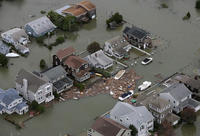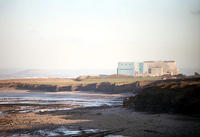-
Innovative Atmospheric Vortex Engine for energy generation
A Canadian company offers a new energy generation concept: the Atmospheric Vortex Engine (AVE) uses low-temperature waste heat to create a tornado-like atmospheric vortex; in contrast with a real tornado, the vortex cannot go anywhere because it is anchored to its heat source. So it is really more like a dust devil or waterspout, and it serves as a low-cost virtual chimney
-
-
EPA issues new soot pollution standard over industry’s objections
The Environmental Protection Agency (EPA), acting under court order, on Friday issued a new standard for soot pollution; the agency estimates the cost of complying to be between $53 million and $350 million – and the estimated benefits to be between $4 billion and $9 billion; utilities, manufacturers, chemical companies, and the oil and gas industry asked for a delay in issuing the rule, arguing it would be costly to implement
-
-
Insurance industry paying increasing attention to climate change-related risks

The insurance industry, the world’s largest business with $4.6 trillion in revenues, is making larger efforts to manage climate change-related risks, according to a new study; weather- and climate-related insurance losses today average $50 billion a year; these losses have more than doubled each decade since the 1980s, adjusted for inflation
-
-
Cybersecurity company using hackers own devices against them
A California cybersecurity start-up, marketing itself as a private cyber intelligence agency, works to identify foreign attackers who are attempting to steal corporate secrets; it does so by using the attackers’ own techniques and vulnerabilities against them; the company also collects data on hackers and tricks intruders into stealing false information
-
-
Modeling terrorism risk to the air transportation system
RAND recently evaluated a terrorism risk modeling tool developed by the Transportation Security Administration (TSA) and Boeing to help guide program planning for aviation security; the Risk Management Analysis Tool, or RMAT, simulates terrorist behavior and success in attacking vulnerabilities in the domestic commercial air transportation system, drawing on estimates of terrorist resources, capabilities, preferences, decision processes, intelligence collection, and operational planning
-
-
Huawei rejects U.S. “threat to national security” claims
In October the United States House Intelligence Committee issued a report warning U.S. companies against using two Chinese companies, Huawei and ZTE, for their telecommunication technology needs; the report said that the firms may be too close to China’s Communist Party and its military’ the report also suggested their products and services could pose a threat to the security of the United .States; Huawei vigorously disputes both claims
-
-
Critics: post-Fukushima nuclear power may be safer, but it is still not cost effective
The Southern Company wants to show its customers that it has learned from the Fukushima disaster in Japan and has protected its nuclear reactors to make sure the same thing does not happen in the United .States’ critics of nuclear power are not convinced – and also, they say, alternative energy sources, such as natural gas, are much cheaper to produce
-
-
Life of U.K. nuclear power plants extended

U.K. operator EDF Energy has announced it will extend the expected operating life of two of its nuclear power stations by seven years; Hinkley Point B and Hunterston B power stations are now expected to remain operational until at least 2023, generating enough electricity for around two million homes; the decision follows the five year extensions to Heysham 1 and Hartlepool announced in 2010 and come after extensive reviews of the plants’ safety cases and continuing work with the independent nuclear regulator
-
-
Company illegally stores 6 million pounds of explosives, neighboring town evacuated
The 800 residents of the town of Doyline, located about 270 miles northwest of New Orleans, were hastily evacuated Friday, and may be forced to stay away until today (Tuesday), after the authorities found more the six million pounds of explosives illegally stored on the grounds of Camp Minden, which used to house the Louisiana Army Ammunitions Plant
-
-
New York is home of the terror bar
Islamic terrorists from around the world are being extradited to the Federal District Court in Manhattan or Brooklyn to face prosecution, which is a boon for the qualified lawyers who defend them; the skills these lawyers display often go beyond what can be taught in law school
-
-
Responding to future oil spills: lessons learned from Deepwater Horizon
A special collection of articles about the Deepwater Horizon oil spill provides the first comprehensive analysis and synthesis of the science used in the unprecedented response effort by the government, academia, and industry;with the benefit of hindsight and additional analyses, these papers evaluate the accuracy of the information that was used in real-time to inform the response team and the public
-
-
DARPA’s program to reveal backdoors, hidden malicious functionality in commercial IT devices

The scenario is one that information security experts dread: widespread dissemination of commercial technology which is secretly wired to function in unintended ways or even spy on its users; from this vantage point, mobile phones, network routers, computer work stations, and any other device hooked up to a network can provide a point of entry for an adversary; for the Department of Defense this issue is of great concern, and DARPA pland to do something about it
-
-
New U.S/Canada Border Conference aims to advance “Beyond the Border” declaration
To further the goals of the February 2011 U.S.-Canada joint declaration, “Beyond the Border: A Shared Vision for Perimeter Security and Economic Competitiveness,” Eagle Eye Expositions, LLC will present a new event called the U.S./Canada Border Conference; the event will take place 10-11 September 2013 at the Cobo Center, Detroit Michigan
-
-
Mixing oil with dispersant increased toxicity to Gulf’s ecosystems
If the 4.9 million barrels of oil that spilled into the Gulf of Mexico during the 2010 Deep Water Horizon spill was an ecological disaster, the two million gallons of dispersant used to clean it up apparently made it even worse – fifty-two-times more toxic
-
-
Fracking in Michigan
In hydraulic fracturing, large amounts of water, sand and chemicals are injected deep underground to break apart rock and free trapped natural gas; though the process has been used for decades, recent technical advances have helped unlock vast stores of previously inaccessible natural gas, resulting in a fracking boom; researchers are examining the benefits of fracking for Michigan
-
More headlines
The long view
Factories First: Winning the Drone War Before It Starts
Wars are won by factories before they are won on the battlefield,Martin C. Feldmann writes, noting that the United States lacks the manufacturing depth for the coming drone age. Rectifying this situation “will take far more than procurement tweaks,” Feldmann writes. “It demands a national-level, wartime-scale industrial mobilization.”
Trump Is Fast-Tracking New Coal Mines — Even When They Don’t Make Economic Sense
In Appalachian Tennessee, mines shut down and couldn’t pay their debts. Now a new one is opening under the guise of an “energy emergency.”
Smaller Nuclear Reactors Spark Renewed Interest in a Once-Shunned Energy Source
In the past two years, half the states have taken action to promote nuclear power, from creating nuclear task forces to integrating nuclear into long-term energy plans.
